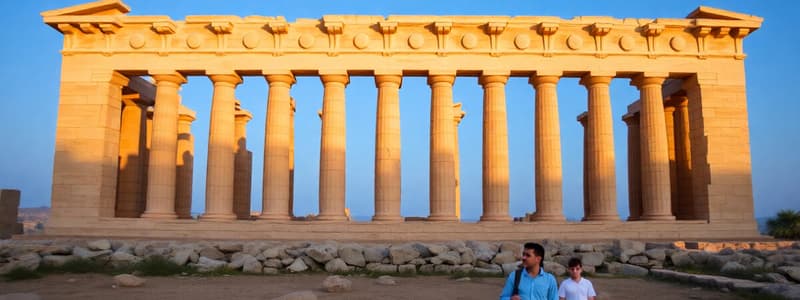Podcast
Questions and Answers
What can ecofacts reveal about past human behavior?
What can ecofacts reveal about past human behavior?
- Cultural practices and traditions
- Environmental conditions and resource use (correct)
- Technological advancements
- Political structures
Processual archaeology is primarily concerned with human agency and individual experiences.
Processual archaeology is primarily concerned with human agency and individual experiences.
False (B)
Explain the law of superposition in archaeological stratigraphy.
Explain the law of superposition in archaeological stratigraphy.
The law of superposition states that in undisturbed strata, the oldest layers are at the bottom and the younger layers are at the top.
The __________ approach in archaeology emphasizes science and hypothesis testing.
The __________ approach in archaeology emphasizes science and hypothesis testing.
Match the following archaeologists with their contributions:
Match the following archaeologists with their contributions:
Why does historical archaeology align most closely with postprocessual archaeology?
Why does historical archaeology align most closely with postprocessual archaeology?
The gumshoe survey is a systematic and formal method of surveying archaeological sites.
The gumshoe survey is a systematic and formal method of surveying archaeological sites.
What is one key difference between processual and postprocessual archaeology?
What is one key difference between processual and postprocessual archaeology?
What type of dating method involves arranging artifacts in a sequence based on stylistic changes over time?
What type of dating method involves arranging artifacts in a sequence based on stylistic changes over time?
The Beringia Standstill hypothesis suggests that human populations moved freely during the last glacial maximum.
The Beringia Standstill hypothesis suggests that human populations moved freely during the last glacial maximum.
What distinguishes historical archaeology from other archaeological practices?
What distinguishes historical archaeology from other archaeological practices?
The Clovis culture is generally dated to around ___ years ago.
The Clovis culture is generally dated to around ___ years ago.
Match the following archaeological terms with their definitions:
Match the following archaeological terms with their definitions:
Which site provided evidence of pre-Clovis human occupation?
Which site provided evidence of pre-Clovis human occupation?
The method that uses the decay of carbon isotopes to date organic materials is called ___ dating.
The method that uses the decay of carbon isotopes to date organic materials is called ___ dating.
Why is the African Burial Ground excavation considered important for historical archaeology?
Why is the African Burial Ground excavation considered important for historical archaeology?
Which method involves collecting data while inherently destroying context?
Which method involves collecting data while inherently destroying context?
The Law of Superposition states that older layers are located above newer layers.
The Law of Superposition states that older layers are located above newer layers.
What is the importance of provenience in archaeology?
What is the importance of provenience in archaeology?
What distinguishes Clovis Points?
What distinguishes Clovis Points?
The __________ method is used to study changes in plant remains from archaeological contexts.
The __________ method is used to study changes in plant remains from archaeological contexts.
Match the dating method with its description:
Match the dating method with its description:
The Beringia Standstill Hypothesis suggests that populations migrated rapidly through Beringia during glacial maximum.
The Beringia Standstill Hypothesis suggests that populations migrated rapidly through Beringia during glacial maximum.
What does 'social organization' refer to in a community?
What does 'social organization' refer to in a community?
Which of the following sites is associated with controversies regarding early human presence in the Americas?
Which of the following sites is associated with controversies regarding early human presence in the Americas?
Radiocarbon dating can be used for dating inorganic materials.
Radiocarbon dating can be used for dating inorganic materials.
In ranked Mississippian society, __________ status refers to social standing that is earned through actions.
In ranked Mississippian society, __________ status refers to social standing that is earned through actions.
Name one factor that affects the preservation of archaeological remains.
Name one factor that affects the preservation of archaeological remains.
Match the following individuals with their contributions to historical archaeology:
Match the following individuals with their contributions to historical archaeology:
What role does 'intersectionality' play in social contexts?
What role does 'intersectionality' play in social contexts?
The discovery at the African Burial Ground (1991) involved an ancient European burial site.
The discovery at the African Burial Ground (1991) involved an ancient European burial site.
What is 'gender bias in archaeology'?
What is 'gender bias in archaeology'?
Flashcards
Beringia Standstill hypothesis
Beringia Standstill hypothesis
The theory suggesting human populations were stalled in Beringia during the last glacial maximum.
Monte Verde
Monte Verde
A site in Chile dated to around 14,500 BP, with evidence of early coastal adaptation.
Clovis points
Clovis points
Distinctive stone tools associated with the Clovis culture.
Dendrochronology
Dendrochronology
Signup and view all the flashcards
Radiocarbon dating
Radiocarbon dating
Signup and view all the flashcards
Historical Archaeology
Historical Archaeology
Signup and view all the flashcards
Ecofacts
Ecofacts
Signup and view all the flashcards
Provenance
Provenance
Signup and view all the flashcards
Ecofacts vs. Artifacts
Ecofacts vs. Artifacts
Signup and view all the flashcards
Processual vs. Postprocessual Archaeology
Processual vs. Postprocessual Archaeology
Signup and view all the flashcards
Law of Superposition
Law of Superposition
Signup and view all the flashcards
Stratigraphy
Stratigraphy
Signup and view all the flashcards
Historical Archaeology
Historical Archaeology
Signup and view all the flashcards
NAGPRA
NAGPRA
Signup and view all the flashcards
Survey in Archaeology
Survey in Archaeology
Signup and view all the flashcards
Settlement Pattern
Settlement Pattern
Signup and view all the flashcards
Pre-Clovis Controversy
Pre-Clovis Controversy
Signup and view all the flashcards
Social Organization
Social Organization
Signup and view all the flashcards
Gender Roles
Gender Roles
Signup and view all the flashcards
Middle-Range Theory
Middle-Range Theory
Signup and view all the flashcards
Historical Archaeology
Historical Archaeology
Signup and view all the flashcards
Jamestown Rediscovery
Jamestown Rediscovery
Signup and view all the flashcards
African Burial Ground
African Burial Ground
Signup and view all the flashcards
Social Status
Social Status
Signup and view all the flashcards
Excavation Methods
Excavation Methods
Signup and view all the flashcards
Bias in Archaeology
Bias in Archaeology
Signup and view all the flashcards
Context & Provenience
Context & Provenience
Signup and view all the flashcards
Absolute vs. Relative Dating
Absolute vs. Relative Dating
Signup and view all the flashcards
Diagnostic Artifacts
Diagnostic Artifacts
Signup and view all the flashcards
Faunal Analysis
Faunal Analysis
Signup and view all the flashcards
Taphonomy
Taphonomy
Signup and view all the flashcards
Peopling of Americas
Peopling of Americas
Signup and view all the flashcards
Study Notes
Draft Test Format
- 25 multiple choice questions (3 points each)
- 5 fill-in-the-blank questions (4 points each)
- 2 short-answer questions (5 points each)
- Total points: 105
- Maximum possible score: 100 (5 points extra credit possible)
Example Fill-in-the-Blank Questions
- Archaeologists study artifacts and... natural objects found at sites.
- The theory that human populations were stalled in Beringia during the last glacial maximum is called the... Beringia Standstill Hypothesis.
- An artifact that can be dated to a specific period based on its style or form is known as a... diagnostic artifact.
- The law that states younger layers of soil are deposited above older layers is called the law of... superposition.
- The method of dating based on tree rings is known as... dendrochronology.
- Archaeologists at Monte Verde found evidence of a... adaptation, indicating coastal living.
- Monte Verde is a site located in... Chile.
- Archaeology that combines the study of material culture and written records is known as... historical archaeology.
- The distinctive stone tools associated with the Clovis culture are called... Clovis points.
- [Site in Pennsylvania that provided evidence of pre-Clovis human occupation]... Meadowcroft Rockshelter.
- In archaeology, an artifact's exact location in relation to the ground or other artifacts is called its... provenience.
- The first widely accepted evidence of humans in N America came from... a site in New Mexico.
- [Type of relative dating method]... seriation.
- The Clovis culture is generally dated to around... 13,000 years ago.
- The method that uses the decay of carbon isotopes to date organic materials is called... radiocarbon dating (C14).
Historical Archaeology
- Aligns most closely with... postprocessual archaeology.
Short Answer Examples
- The significance of the Monte Verde site in challenging the Clovis-first model, and how it changes our understanding of early human migration in the Americas (answer in 2-3 sentences).
- Why is archaeology unique in that it destroys its evidence as it collects data, and what methods do archaeologists use to mitigate this issue?
- Why is the African Burial Ground excavation important for historical archaeology, and how did community involvement influence the project?
- Role of ecofacts in archaeological analysis, difference from artifacts, and what they reveal about past human behavior
- Key differences between processual and postprocessual archaeology, with an example of how they interpret an archaeological site differently
- How archaeologists use the law of superposition and stratigraphy to date artifacts and understand the sequence of human activities at a site
History of Archaeology
- Theoretical frameworks: Culture history, processual, post-processual
- Key figures and discoveries: Boucher de Perthes, Darwin, Marx, Kennewick Man, NAGPRA
- Developments in methods/approaches: Scientific methods, hypothesis testing, relative and absolute dating techniques (dendrochronology, radiocarbon dating, stratigraphy)
- Paradigms: Processual, postprocessual
Structures of Inquiry.
- Covers: Processual, postprocessual, and culture history approaches, including methods like hypothesis testing in cultural history
- Include: Anthropology, bio-cultural, scientific & theoretical studies of humankind, self-correcting theories
Survey in Archaeology
- Goals/methods: Find sites, understand landscapes, settlement patterns
- Various approaches: Ground-penetrating radar, non-invasive surveying techniques, settlement pattern analysis
Excavation
- Essential elements: Context and provenience, understanding context and location of finds, precise recording of artifacts
Dating
- Approaches: Absolute (precise dates e.g., radiocarbon dating, diagnostic artifacts, index fossils) vs. relative (chronological order e.g., seriation, dendrochronology)
Plants and Animals
- Subjects: Faunal and floral analysis (identifying remains), paleoethnobotany, ecofacts
Additional Topics
- Social organization: Rules, gender, kinship, social status, ritual
- Historical archaeology: Material culture, colonialism, indigenous, non-Western perspectives, combines archaeology & documentation
- Important sites: Monte Verde, Meadowcroft Rockshelter, Jamestown
Studying That Suits You
Use AI to generate personalized quizzes and flashcards to suit your learning preferences.





